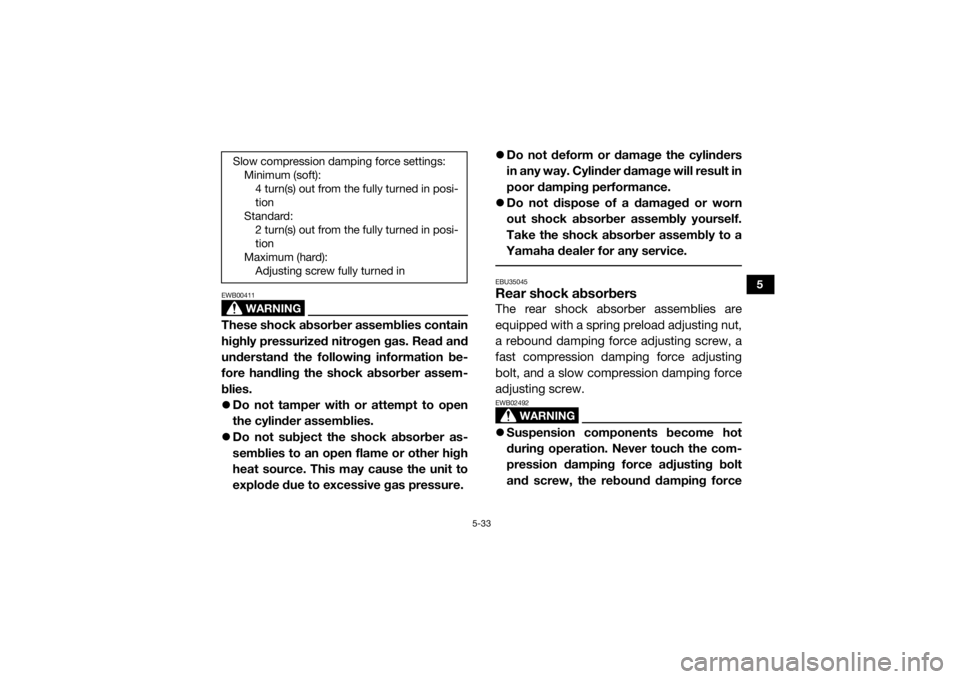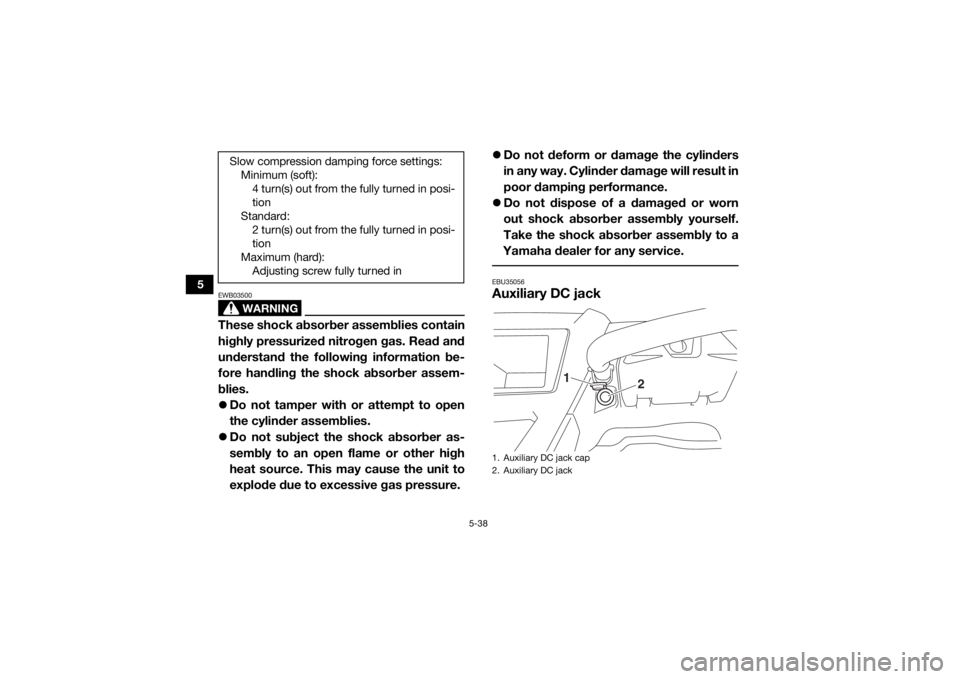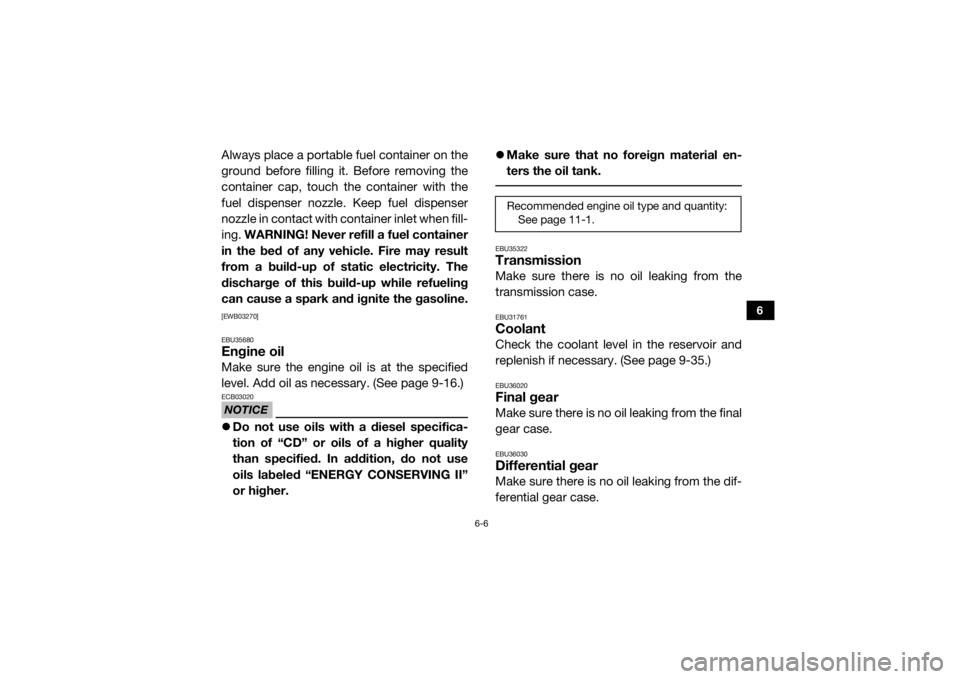warning YAMAHA YXZ1000R 2020 Owner's Manual
[x] Cancel search | Manufacturer: YAMAHA, Model Year: 2020, Model line: YXZ1000R, Model: YAMAHA YXZ1000R 2020Pages: 198, PDF Size: 8.22 MB
Page 60 of 198

5-28
5
EBU35660Flag pole bracketThis model is equipped with a flag pole brack-
et.NOTICEECB03010Do not use the flag pole bracket as a cargo
hook.
EBU35035Front shock absorbersThe shock absorber assemblies are equipped
with a spring preload adjusting nut, a rebound
damping force adjusting screw, a fast com-
pression damping force adjusting bolt, and a
slow compression damping force adjusting
screw.
WARNING
EWB02492Suspension components become hot
during operation. Never touch the com-
pression damping force adjusting bolt
and screw, the rebound damping force
adjusting screw or the oil reservoir with
your bare hand or skin until suspension
components have cooled.
Always adjust the shock absorber as-
semblies on the left and right side to the
same setting. Uneven adjustment can
cause poor handling and loss of stability,
which could lead to an accident.
1. Flag pole bracket
1
1
UB5J7BE0.book Page 28 Tuesday, June 18, 2019 10:07 AM
Page 65 of 198

5-33
5
WARNING
EWB00411These shock absorber assemblies contain
highly pressurized nitrogen gas. Read and
understand the following information be-
fore handling the shock absorber assem-
blies.
Do not tamper with or attempt to open
the cylinder assemblies.
Do not subject the shock absorber as-
semblies to an open flame or other high
heat source. This may cause the unit to
explode due to excessive gas pressure.
Do not deform or damage the cylinders
in any way. Cylinder damage will result in
poor damping performance.
Do not dispose of a damaged or worn
out shock absorber assembly yourself.
Take the shock absorber assembly to a
Yamaha dealer for any service.
EBU35045Rear shock absorbersThe rear shock absorber assemblies are
equipped with a spring preload adjusting nut,
a rebound damping force adjusting screw, a
fast compression damping force adjusting
bolt, and a slow compression damping force
adjusting screw.
WARNING
EWB02492 Suspension components become hot
during operation. Never touch the com-
pression damping force adjusting bolt
and screw, the rebound damping force
Slow compression damping force settings:
Minimum (soft):4 turn(s) out from the fully turned in posi-
tion
Standard: 2 turn(s) out from the fully turned in posi-
tion
Maximum (hard): Adjusting screw fully turned in
UB5J7BE0.book Page 33 Tuesday, June 18, 2019 10:07 AM
Page 70 of 198

5-38
5
WARNING
EWB03500These shock absorber assemblies contain
highly pressurized nitrogen gas. Read and
understand the following information be-
fore handling the shock absorber assem-
blies.
Do not tamper with or attempt to open
the cylinder assemblies.
Do not subject the shock absorber as-
sembly to an open flame or other high
heat source. This may cause the unit to
explode due to excessive gas pressure.
Do not deform or damage the cylinders
in any way. Cylinder damage will result in
poor damping performance.
Do not dispose of a damaged or worn
out shock absorber assembly yourself.
Take the shock absorber assembly to a
Yamaha dealer for any service.
EBU35056Auxiliary DC jack
Slow compression damping force settings: Minimum (soft):4 turn(s) out from the fully turned in posi-
tion
Standard: 2 turn(s) out from the fully turned in posi-
tion
Maximum (hard): Adjusting screw fully turned in
1. Auxiliary DC jack cap
2. Auxiliary DC jack
2
1
UB5J7BE0.book Page 38 Tuesday, June 18, 2019 10:07 AM
Page 72 of 198

6-1
6
EBU31574
FOR YOUR SAFETY – PRE-OPERATION CHECKS
EBU31584Before starting off, inspect the vehicle to make sure it is in safe operating condition. Use the fol-
lowing checklist and related information as a guide. Also, follow the service intervals in the peri-
odic maintenance chart to keep the vehicle in safe operating condition.
WARNING
EWB00482Failure to inspect or maintain the vehicle properly increases the possibility of an accident
or equipment damage. Do not operate the vehicle if you find any problem. If a problem can-
not be corrected by the procedures provided in this manual, have the vehicle inspected by
a Yamaha dealer. Pre-operation checklist
ITEM ROUTINE PAGE
Brakes • Check operation, free play, fluid level, and fluid leakage.
• Fill with DOT 4 brake fluid if necessary. 6-3, 9-46, 9-52
Clutch • Check operation, free play, fluid level, and fluid leakage.
• Fill with DOT 4 brake fluid if necessary. 6-3, 9-49
Parking brake • Check for proper operation, condition, and free play. 9-51
Fuel • Check fuel level.
• Fill with the recommended fuel if necessary. 6-4
UB5J7BE0.book Page 1 Tuesday, June 18, 2019 10:07 AM
Page 75 of 198

6-4
6
Clutch fluid
Depress and release the clutch pedal five
times. Check to see if any fluid is leaking out
of the hoses, reservoir, or master cylinder.
Check the clutch fluid level and correct if nec-
essary. (See page 9-47.)TIPIf any leakage is found, or if the clutch pedal
offers little resistance, have a Yamaha dealer
service the vehicle. EBU36972FuelMake sure there is sufficient fuel in the tank.
Refuel if necessary.
WARNING
EWB02522Gasoline and gasoline vapors are ex-
tremely flammable. To avoid fires and ex-
plosions and to reduce the risk of injury
when refueling, follow these instructions.
1. Before refueling, turn off the engine andbe sure that no one is sitting in the vehi-
cle.
Never refuel while smoking, or while in
the vicinity of sparks, open flames, or
other sources of ignition such as the pilot
lights of water heaters and clothes dry-
ers.
2. Do not overfill the fuel tank. Because fuel expands when it heats up, heat from the
engine or the sun can cause fuel to spill
out of the fuel tank.
3. Wipe up any spilled fuel immediately.
4. Be sure the fuel tank cap is closed se- curely.
WARNING
EWB02532Gasoline is poisonous and can cause inju-
ry or death. Handle gasoline with care.
Never siphon gasoline by mouth. If you
should swallow some gasoline or inhale a
lot of gasoline vapor, or get some gasoline
in your eyes, see your doctor immediately.
UB5J7BE0.book Page 4 Tuesday, June 18, 2019 10:07 AM
Page 77 of 198

6-6
6
Always place a portable fuel container on the
ground before filling it. Before removing the
container cap, touch the container with the
fuel dispenser nozzle. Keep fuel dispenser
nozzle in contact with container inlet when fill-
ing. WARNING! Never refill a fuel container
in the bed of any vehicle. Fire may result
from a build-up of static electricity. The
discharge of this build-up while refueling
can cause a spark and ignite the gasoline.[EWB03270]
EBU35680Engine oilMake sure the engine oil is at the specified
level. Add oil as necessary. (See page 9-16.)NOTICEECB03020 Do not use oils with a diesel specifica-
tion of “CD” or oils of a higher quality
than specified. In addition, do not use
oils labeled “ENE RGY CONSERVING II”
or higher.
Make sure that no foreign material en-
ters the oil tank.
EBU35322TransmissionMake sure there is no oil leaking from the
transmission case.EBU31761CoolantCheck the coolant level in the reservoir and
replenish if necessary. (See page 9-35.)EBU36020Final gearMake sure there is no oil leaking from the final
gear case.EBU36030Differential gearMake sure there is no oil leaking from the dif-
ferential gear case.Recommended engine oil type and quantity: See page 11-1.
UB5J7BE0.book Page 6 Tuesday, June 18, 2019 10:07 AM
Page 79 of 198

6-8
6
EBU35690Shift leverThe shift lever should move smoothly both
forward and backwards and return to its orig-
inal position after a gear change is made.
Check the shift lever and transmission for
roughness before starting off.TIPThe engine may need to be started for the
transmission to engage gears. EBU31832Fittings and fastenersAlways check the tightness of chassis fittings
and fasteners before starting off. Take the ve-
hicle to a Yamaha dealer or refer to the Servi-
ce Manual for correct tightening torque.EBU31840Instruments, lights and switchesCheck that all instruments, lights and switch-
es are working properly. Correct if necessary.
EBU31851Control cablesWhen driving in cold weather, always make
sure all control cables work smoothly before
starting off. WARNING! Control cables can
freeze in cold weather and you could be
unable to control the vehicle.
[EWB03280]
EBU37893
TiresCheck and adjust the tire pressure before
each ride. Check tires for wear and damage.
Tire pressure1. Tire pressure gauge
1
UB5J7BE0.book Page 8 Tuesday, June 18, 2019 10:07 AM
Page 80 of 198

6-9
6
A tire pressure gauge is included as standard
equipment. Make two measurements of the
tire pressure and use the second reading.
Dust or dirt in the gauge could cause the first
reading to be incorrect.
Tire pressure must be checked and set when
the tires are cold. The tire pressure should be
the same on both sides, and must be adjust-
ed according to vehicle loading conditions.
Set the tire pressure as specified below.
WARNING! Operation of this vehicle with
improper tire pressure may cause severe
injury or death from loss of control or roll-
over. Tire pressure below the minimum
specified could also cause the tire to dis-
lodge from the rim under severe driving
conditions.
[EWB04120]
OPERATING TIRE PRESSURE (cold): VEHICLE LOAD of 0.0–195.0 kg (0–430 lb) FRONT: (Recommended)114.0 kPa (1.140 kgf/cm², 16.5 psi)
REAR: (Recommended) 128.0 kPa (1.280 kgf/cm², 18.5 psi)
Front: (Minimum) 110.0 kPa (1.100 kgf/cm², 16.0 psi)
Rear: (Minimum) 124.0 kPa (1.240 kgf/cm², 18.0 psi)
VEHICLE LOAD of 195.0–328.0 kg (430–
723 lb) FRONT: (Recommended)114.0 kPa (1.140 kgf/cm², 16.5 psi)
REAR: (Recommended) 169.0 kPa (1.690 kgf/cm², 24.5 psi)
Front: (Minimum) 110.0 kPa (1.100 kgf/cm², 16.0 psi)
Rear: (Minimum) 165.0 kPa (1.650 kgf/cm², 24.0 psi)
Vehicle load is total weight of operator, pas-
senger, accessories, and cargo. Do not ex-
ceed maximum vehicle load of 328.0 kg
(723 lb).
UB5J7BE0.book Page 9 Tuesday, June 18, 2019 10:07 AM
Page 82 of 198

7-1
7
EBU31872
OPERATION
EBU31880Read the Owner’s Manual carefully to be-
come familiar with all controls. If there is a
control or function you do not understand,
ask your Yamaha dealer.
WARNING
EWB03290Failure to familiarize yourself with the con-
trols can lead to loss of control, which
could cause an accident or injury. EBU35720Engine break-inThere is never a more important period in the
life of your vehicle than the period between 0
and 20 hours.
For this reason, we ask that you read the fol-
lowing material carefully. Because the engine
is brand new, you must not put an excessive
load on it for the first several hours of opera-
tion. During the first 20 hours, the variousparts in the engine wear and polish them-
selves to achieve the correct operating clear-
ances.
During this period, prolonged full-throttle op-
eration or any condition that might result in
excessive engine heating must be avoided.
However, momentary (2–3 seconds maxi-
mum) full-throttle operation under load does
not harm the engine.
Each full-throttle acceleration sequence
should be followed with a substantial rest pe-
riod for the engine, by cruising at lower r/min
so the engine can rid itself of the temporary
build-up of heat. If any abnormality is noticed
during this period, consult a Yamaha dealer.
0–10 hours:
Avoid prolonged operation above 5300 r/min.
Allow a cooling-off period of 5 to 10 minutes
after every hour of operation. Vary the speed
of the vehicle from time to time. Do not oper-
ate it at one set throttle position.UB5J7BE0.book Page 1 Tuesday, June 18, 2019 10:07 AM
Page 83 of 198

7-2
7
10–20 hours:
Avoid prolonged operation above 6300 r/min.
After break-in:
The vehicle may now be operated normally.EBU35342Starting the engine1. Turn the key to “ ” (on).NOTICEECB02291The coolant temperature warning light and
engine trouble warning light should come
on, then go off.
The EPS warning light should come on,
then go off when the engine is started.
To avoid possible damage, do not operate
the vehicle if a warning light does not work
as described above. 2. Press the brake pedal.
3. Shift the transmission into neutral.
When the transmission is in the neutral
position, the transmission gear display
shows “N” and the neutral indicator
light should come on.
The engine can be started in any gear if
the clutch pedal is applied. However, it
is recommended to shift into neutral
before starting the engine.
4. With your foot off the accelerator pedal, start the engine by turning the key to “ ”
(start).
If the engine fails to start, release the key, and
then try starting it again. Wait a few seconds
before the next attempt. Each attempt should
be as short as possible, to preserve battery
energy. NOTICE: Do not crank the engine
more than 5 seconds on each attempt, or
starter damage could occur. Wait at least
5 seconds between each operation of the
electric starter to let it cool.
[ECB02140]
Do not turn the key to the “ ” (start) position
with the engine running; otherwise, damage
to the electric starter may result.
UB5J7BE0.book Page 2 Tuesday, June 18, 2019 10:07 AM